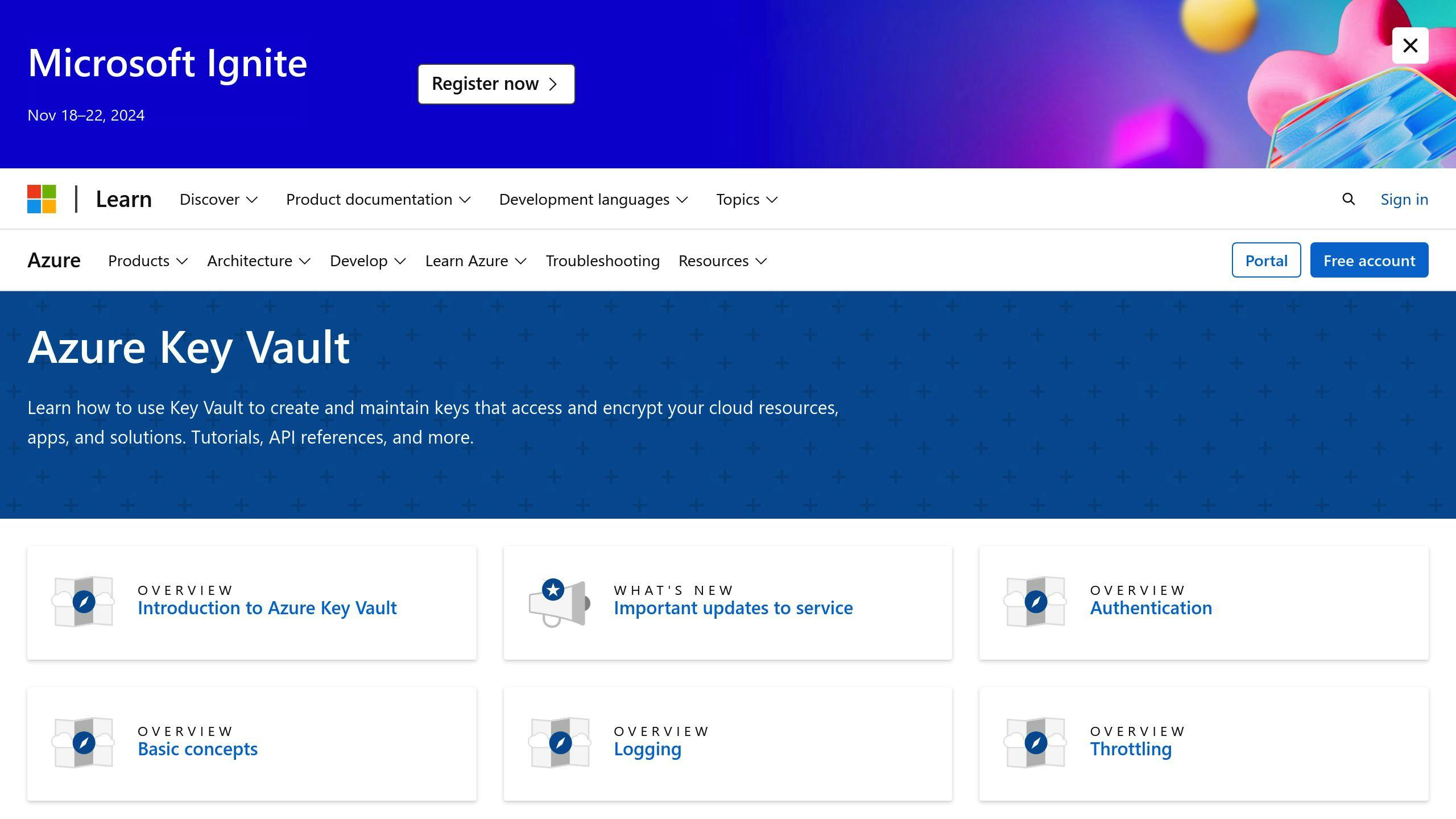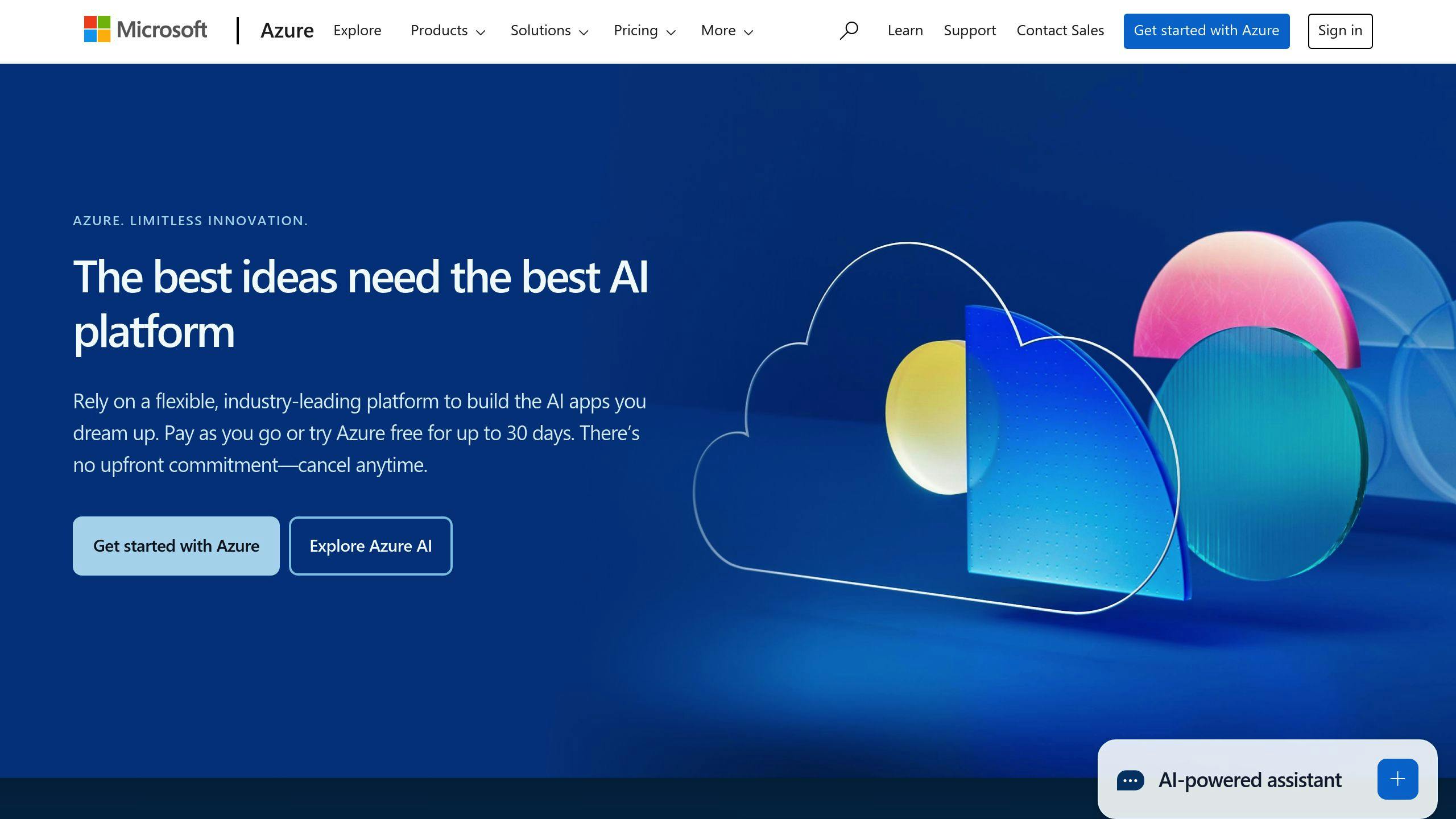Azure Key Vault is your digital fortress for sensitive data in the cloud. Here's what you need to know:
- It's a secure service for storing secrets, keys, and certificates
- Keeps sensitive info separate from your app's code
- Uses strong encryption and access controls
- Integrates with other Azure services
Key features:
- Secret storage
- Key management
- Certificate management
- Access control
- Monitoring and logging
Setting up Azure Key Vault:
- Create a vault in Azure portal
- Set up Managed Identity for your app
- Configure access controls (RBAC recommended)
Best practices:
- Use different vaults for dev, staging, and production
- Name secrets clearly and use tags
- Set expiration dates on secrets
- Automate secret rotation
- Enable logging and monitoring
Using in .NET apps:
- Install Azure.Identity and Azure.Security.KeyVault.Secrets packages
- Connect using DefaultAzureCredential
- Retrieve secrets with SecretClient
Remember:
- Keep secrets out of your code and config files
- Use Managed Identity when possible
- Handle exceptions when accessing secrets
Azure Key Vault helps you meet compliance requirements and keeps your sensitive data locked down tight.
Related video from YouTube
Setting Up Azure Key Vault

Let's dive into setting up Azure Key Vault to keep your app's sensitive info under lock and key.
Create Your First Key Vault
Creating a Key Vault is a breeze. Here's how:
- Log into the Azure portal
- Hit "Create a resource"
- Type "Key Vault" in the search bar and select it
- Click "Create"
- Fill in the basics:
- Pick a unique name (like "Contoso-vault2")
- Choose your subscription
- Select or create a resource group
- Pick a location
- Keep other settings as they are
- Hit "Create"
Once it's up and running, jot down the Vault Name and Vault URI. You'll need these to connect your apps to the vault later.
Set Up Managed Identity
Managed Identity is a game-changer. It lets your apps talk to Key Vault without storing any secrets in your code. Here's how to set it up for your Azure App Service:
- Find your App Service in the Azure portal
- Go to "Settings" > "Identity"
- Flip the "System assigned managed identity" switch to "On"
- Save your changes
This gives your app its own identity in Azure Active Directory, which it can use to access Key Vault without any credentials in your code.
Set Up Access Controls
Azure Key Vault offers two ways to control access: Role-Based Access Control (RBAC) and Vault Access Policy. Microsoft's giving RBAC the thumbs up because it fits in with Azure's usual access control setup.
Here's how to set up RBAC for your Key Vault:
- Open your Key Vault in the Azure portal
- Head to "Access control (IAM)"
- Click "Add" > "Add role assignment"
- Pick a role (like "Key Vault Secrets User" if you just need to read secrets)
- Choose your app service's managed identity
- Hit "Save"
Make sure you're giving out the right permissions. Azure's got a bunch of built-in roles for Key Vault:
- Key Vault Administrator
- Key Vault Reader
- Key Vault Secrets Officer
- Key Vault Secrets User
- Key Vault Crypto Officer
- Key Vault Crypto User
- Key Vault Crypto Service Encryption User
Pick the role that fits what your app needs to do, but don't give it more power than necessary.
"Managed Identity simplifies access management by eliminating the need for manual credential handling." - Hadiyal Urmal, Author
Heads up: If you switch from Access Policies to RBAC, your old access policy permissions will stop working right away. Make sure you've set up all the RBAC permissions you need before making the switch, or you might lock yourself out of your vault.
Managing Secrets Effectively
Azure Key Vault keeps your sensitive info safe. But you need to handle these secrets well throughout their life. Let's look at how to organize, update, and track your secrets in Azure Key Vault.
Organizing Your Secrets
Good organization keeps your secrets secure and easy to manage. Here's how:
-
Name things clearly: Use a pattern like
<app>-<env>-<secrettype>-<description>. It helps you find and manage secrets easily. - Use tags: Tags in Azure Key Vault help sort and filter secrets. Try tagging with things like "Environment" or "Application".
- Split by environment: Have different key vaults for dev, staging, and production. It helps control access and stops mix-ups between environments.
- Group related secrets: For secrets from the same app or service, use a common name prefix or tags to group them.
Updating and Managing Secrets
Regular updates keep your secrets secure. Here's how to do it:
- Set end dates: Always set an expiration date when you create secrets. It reminds you to review and change them. Microsoft suggests 1-2 year expiry dates.
- Automate rotation: Azure Key Vault doesn't auto-rotate secrets, but you can set it up. An Azure Function could create and update secrets on a schedule.
- Use managed identities: When you can, use Azure Managed Identities. Azure handles the auth, so you don't need to store some types of secrets.
- Handle updates smoothly: Make sure your apps can deal with secret changes without stopping. Have your app check for updated secrets now and then.
- Give least privilege: When giving access to secrets, only give the minimum needed permissions. Use roles like "Key Vault Secrets User" for apps that just need to read secrets.
Track Secret Usage
Watching how your secrets are used keeps things secure and compliant. Azure has tools to help:
- Turn on logging: Enable diagnostic logging for your Key Vault. It records details about secret access and actions. Send these logs to Azure Monitor to analyze.
- Set up alerts: Create Azure Monitor alerts for odd activities, like many failed access attempts or unexpected deletions.
- Use Event Grid: Connect Key Vault events to Azure Event Grid. It lets you react right away when secrets are created, updated, or about to expire.
- Review access: Regularly check who can access your Key Vault and what they can do. Make sure access stays appropriate over time.
- Use Key Vault Insights: This Azure Monitor feature shows your Key Vault requests, performance, and failures in one place. It helps spot patterns in secret usage and potential issues.
sbb-itb-29cd4f6
Using Azure Key Vault in .NET Apps

Azure Key Vault boosts your .NET app's security by keeping sensitive info like connection strings and API keys safe. Here's how to use it:
Install Required Packages
First, add these NuGet packages to your project:
dotnet add package Azure.Identity
dotnet add package Azure.Security.KeyVault.Secrets
These give you the tools to talk to Azure and work with Key Vault secrets.
Connect Your App
Connecting to Key Vault is easy:
using Azure.Identity;
using Azure.Security.KeyVault.Secrets;
string keyVaultUrl = "https://your-vault-name.vault.azure.net/";
var client = new SecretClient(new Uri(keyVaultUrl), new DefaultAzureCredential());
DefaultAzureCredential is pretty cool. It tries different ways to log in, so you can use the same code in development and production.
Get and Use Secrets
Now, let's grab a secret:
string secretName = "MyDatabaseConnectionString";
KeyVaultSecret secret = client.GetSecret(secretName);
string connectionString = secret.Value;
using (var connection = new SqlConnection(connectionString))
{
// Do your database stuff here
}
This keeps your sensitive data out of your code and config files. Much safer!
"Managed Identity makes access management a breeze. No more manual credential juggling." - Hadiyal Urmal, Author
For local development, use user secrets or environment variables. In production, switch to Key Vault without changing your code.
Don't forget to handle exceptions when getting secrets. Network hiccups or permission issues could cause problems. Always have a backup plan or good error handling.
Pro Tip: When using Azure App Service, turn on Managed Identity. Your app can then talk to Key Vault without any credentials in your code or config.
Keeping Your Secrets Safe
Azure Key Vault doesn't just store your secrets - it locks them up tight. Let's see how it keeps your sensitive info secure and helps you stay compliant.
How Encryption Works
Azure Key Vault uses envelope encryption to protect your secrets. Here's the process:
- Your secret gets encrypted with a Data Encryption Key (DEK)
- The DEK gets encrypted with a Key Encryption Key (KEK)
- The encrypted DEK is stored with your secret in Azure Key Vault
This multi-layer approach means hackers would need to break through multiple encryption levels to access your secrets.
Azure Key Vault also encrypts your data at rest and in transit:
- At rest: Secrets are encrypted on disk using symmetric encryption
- In transit: Transport Layer Security (TLS) protects data moving between components or services
"Microsoft is committed to encryption at rest options across cloud services and giving customers control of encryption keys and logs of key use." - Microsoft Azure Team
Track Changes and Access
Monitoring who accesses your secrets is key for security and compliance. Azure Key Vault offers tools to help you keep watch:
1. Enable data plane auditing
This tracks all activities related to your secrets, keys, and certificates. You'll know who accessed what and when.
2. Use Azure Monitor
Set up alerts for suspicious activities, like multiple failed logins or unexpected deletions.
3. Leverage Key Vault Insights
This Azure Monitor feature gives you a dashboard view of your Key Vault's performance, requests, and failures.
4. Implement Azure Defender for Key Vault
This service uses machine learning to spot and alert you to unusual or potentially harmful access attempts.
5. Regular access reviews
Periodically check who has access to your Key Vault and what permissions they have. This helps maintain the principle of least privilege over time.
Summary
Azure Key Vault is your go-to tool for keeping secrets safe in the cloud. Here's what you need to know:
Key Takeaways
Azure Key Vault is like a digital fortress for your sensitive info. It keeps your encryption keys, certificates, and passwords locked away from your app's code. This separation is a big deal - it makes accidental leaks way less likely.
Don't put all your eggs in one basket. Use different key vaults for different apps and environments. Microsoft says you should have separate vaults for dev, pre-prod, and production. This way, if one vault gets compromised, the others stay safe.
Azure Key Vault plays nice with Azure Active Directory, letting you set up tight access controls. Use Role-Based Access Control (RBAC) to make sure only the right people and apps can get to your secrets. Remember: give people only the permissions they absolutely need.
Your secrets in Azure Key Vault aren't just locked away - they're encrypted too. And if you need extra security, you can use hardware security modules (HSMs) for your most sensitive keys.
Keep an eye on things. Azure Key Vault comes with logging and monitoring tools. Turn on diagnostic logging and hook it up with Azure Monitor. This way, you can see who's accessing your secrets and when. It's great for staying compliant and spotting potential security issues.
Don't let your secrets get stale. Microsoft suggests changing them at least every 60 days. Azure Key Vault makes this easier with its versioning feature, so you can manage multiple versions of a secret.
Lock down your network. Azure Key Vault lets you restrict access to specific IP addresses and virtual networks. Use these features along with Private Link to shrink your key vault's attack surface.
Ditch the credentials in your code. Use Azure Managed Identities instead. It's simpler and safer - your apps can access Key Vault without you having to manage any secrets directly.
Accidents happen. That's why Azure Key Vault has a soft-delete feature. If you turn it on, you can recover deleted vaults and secrets for a set time (between 7 and 90 days). It's like a safety net for your data.
FAQs
Why is it better to save secrets in Azure Key Vault?
Storing secrets in Azure Key Vault is a smart move. Here's why:
It's like having a super-secure digital safe. You control who gets access, and it's all in one place. This setup makes it way harder for secrets to accidentally leak out.
Plus, your developers don't have to worry about hiding sensitive info in their code anymore. It's a win-win.
"Centralizing storage of application secrets in Azure Key Vault allows you to control their distribution. Key Vault greatly reduces the chances that secrets may be accidentally leaked." - Sven Malvik, cloud security expert
What type of authentication is Azure Key Vault?
Azure Key Vault uses Microsoft Entra authentication. It's not a free-for-all - you need a Microsoft Entra security principal to get in.
Who can be a security principal? It could be:
- Users
- Application service principals
- Managed identities for Azure resources
- Groups of any of these types
This setup lets you fine-tune who gets access to what. You can give your dev team one level of access and your production team another. It's all about keeping those sensitive production secrets under wraps.
Which secret permission should be used in Azure Key Vault?
When it comes to secret permissions in Azure Key Vault, Microsoft says go for Role-Based Access Control (RBAC). Here's the deal:
RBAC lets you get super specific. You can give read access to just one object in Key Vault for a user or app. It's all about giving the least amount of access needed - that's just good security practice.
For the big stuff like controlling network access, keeping an eye on things, or managing objects, you'll need permissions at the vault level.


